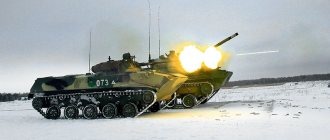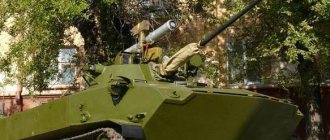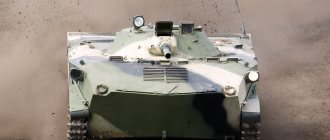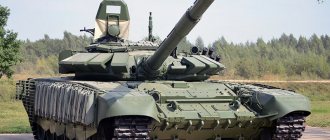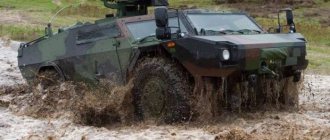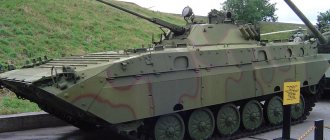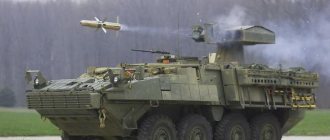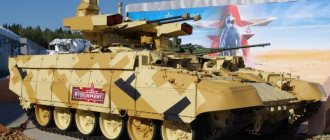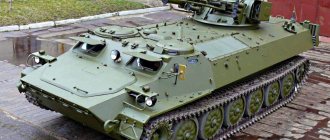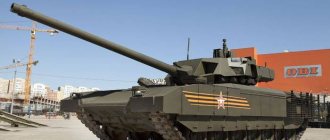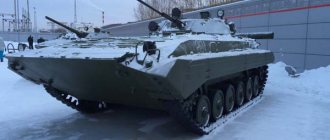Home » Real story » Little-known and unrealized projects of tanks and other armored vehicles » Why are our infantry fighting vehicles exactly like this? Part 2
Little-known and unrealized projects of tanks and other armored vehiclesControversial historyControversial history of the recent past
byakin 04/03/2019 2704
18
in Favoritesin Favoritesfrom Favorites 8
Part 1
Two extremes
As usual, there are no analogues to our BMD-4M. Why? Let's take as a basis only the main indicators of the car for now. Its weight is 14 tons, length is 6.1 meters, height is 2.2 meters, the power of the UTD-29 diesel engine is 500 hp. For comparison, the BMP-3M, unified with it in a number of units, produced by the same Kurganmashzavod, has the following indicators: 22.7 tons with dynamic protection, 7.1 and 2.3 meters, 500 hp. with diesel engine UTD-29 or 660 hp. with UTD-32. It is a bit heavy for landing purposes.
The rare BMD-4 vehicle is the predecessor of the BMD-4M.
The rare BMD-4 vehicle is the predecessor of the BMD-4M.
Abroad, tracked analogues of BMD and BMP are developing in a slightly different direction. Some countries are increasing their defense and thereby dispersing the mass beyond all limits. Here are examples. The American M2 Bradley gained weight from 23 (early modifications) to 30 tons (M2A3 version), while maintaining its buoyancy. Dimensions of the machine: 6.5 and almost 3 meters. Armament: 25 mm cannon and 7.62 machine gun. German Marder: 33 tons, 6.8 and 3 meters, 20 mm cannon, 7.62 machine gun. Can't swim. And finally, the newest German infantry fighting vehicle Puma: 43 tons, 7.3 and 3.1 meters, 30 mm cannon, 5.56 machine gun. Excuse me, but this is the mass of the KV-1 heavy tank from the war. Exactly! Moreover, the height of the promising infantry fighting vehicle is greater than that of the Leopard 2A6 tank. These are the infantry fighting vehicles of a number of NATO countries. Too tall, too heavy, armed only with small-caliber guns. What are the needs of landing and parachute drops? The same Puma can even be transported by air only by the A400M transport aircraft, and only if it is a very lightweight infantry fighting vehicle with a significantly reduced level of protection! It turns out that when transporting by air, we lose what we fenced the garden for.
It is easy to distinguish the “four” from 4M. It has an exhaust system at the stern, while the new one has one on the starboard side at the rear.
It is easy to distinguish the “four” from 4M. It has an exhaust system at the stern, while the new one has one on the starboard side at the rear.
A little about airborne technology
For a long time, UNTV specialists tried to convince the Airborne Forces command of the need to unify light armored vehicles. Commander of the troops, General D.S. Sukhorukov, at a general meeting at the NTK Airborne Forces at that time, even warned them to listen to the NTK UNTV, calling my name. But the paratroopers preferred to go their own way. In addition, we lost time with the adoption of the BMP-3 into service.
As a result, the Airborne Forces command supported the position of the chief designer of VgTZ A.V. Shabalin, who dreamed of developing his own new generation BMD, not unified with the BMP-3. But since the BMD-3 and BPM-4 were based on the new ChTZ engine, the serious problems with which were discussed above, their supplies to the troops were very limited - at the level of trial operation. The paratroopers remained for a long time with the BMD-2, armed with a 30-mm 2A42 cannon in a single turret, a “makeshift” vehicle.
Only in March 2008, at the Kurganmashzavod training ground, the modernized BMD-4M was demonstrated, which is, in fact, a variant of the BMP-3, adapted to the requirements of the Airborne Forces. But this vehicle could appear almost simultaneously with the BMP-3!
Sit down and gasp
The BMD-4M also belongs to the category of lightly armored combat vehicles, although it is heavier than its predecessors. Its body is made of aluminum armor with a bulletproof level of protection. It cannot be otherwise - airborne equipment has strict restrictions on size and weight. Unlike an infantry fighting vehicle, it cannot be given a lot of protection and cannot be turned into an “almost tank”. There’s nothing you can do; you have to design an infantry fighting vehicle with an eye on the size of the compartments and the payload capacity of transport aircraft, and the characteristics of parachute systems. Today, two BMP-4M BMPs can be dropped from the Il-76 transport aircraft. But work is underway to improve aircraft and strapdown parachute systems in order to drop three units of military equipment, that is, a platoon, from one side. Therefore, airborne vehicles should not be criticized for weak armor. In this case, thin armor is better than no armor at all. Of course, there is a reserve for enhancing protection within reason. The vehicle can be equipped with additional steel sheets on the front and sides and modules with ceramic armor. Photos of such BMD-4M can be found on the Internet.
The BMD-4M is equipped with the most modern fire control system and is capable of hitting ground and air targets around the clock.
The BMD-4M is equipped with the most modern fire control system and is capable of hitting ground and air targets around the clock.
As for driving capabilities, in this regard the BMD-4M is a typical representative of the domestic design school. Agile, fast, maneuverable. The power plant is a powerful naturally aspirated diesel engine and a semi-automatic gearbox. Among the car's talents are light steering, a solid power reserve, and the ability to swim with the help of water jet engines (10 km/h with waves up to 3-4 points). Another undoubted advantage is the ability to camouflage. The BMD-4M is already low in comparison with foreign tracked vehicles. Moreover, it is equipped with hydropneumatic suspension with variable ground clearance. The working ground clearance of the BMD-4M is about 450 mm, but it can be increased to 530 or reduced to 130 mm. The military values this ability to “squat”—there are stories that combat vehicles can crawl through a wheat field undetected.
But the main advantage of our lightly armored BMD-4M is its powerful weapons. This is where we are ahead of foreign infantry fighting vehicles and infantry fighting vehicles. Moreover, both light and most heavy ones. The armament block consists of an automatic 100-mm gun-launcher 2A70, a rapid-fire (up to 330 rounds per minute) 2A72 cannon with a caliber of 30 mm and a 7.62 PKTM machine gun.
The armament of the BMD-4M has been stabilized. You can fire on the move.
The armament of the BMD-4M has been stabilized. You can fire on the move.
A single main-caliber automatic loader contains 34 ZUOF19 high-explosive fragmentation projectiles of increased power and firing range and 4 Arkan anti-tank guided missiles with a tandem cumulative warhead. The gun's rate of fire is 10 rounds per minute, and the firing range of shells is up to 7 kilometers. Armor penetration of missiles is 750 mm (equivalent to homogeneous armor with dynamic protection), range is 5500 meters. That is, the BMD-4M can hit any tank.
The small-caliber, rapid-fire 2A72 with a moving barrel is a gun with reduced recoil. Designed for installation in weapon modules with thin armor. The longest firing range at ground targets is 4 kilometers. The ammunition load can include high-explosive incendiary fragmentation, fragmentation tracer, armor-piercing tracer and armor-piercing sub-caliber projectiles with improved penetration (ZUBR8 “Kerner”). The gun is equipped with a double-sided belt feed with automated and manual feed switching.
It should be noted that the BMD-4M is equipped with a modern and effective fire control system. It allows you to hit ground and, importantly, air targets around the clock. From a place and on the move. The complex includes a weapon stabilizer and a ballistic computer, laser rangefinders, a thermal imaging sight with automatic target tracking and a panoramic thermal imaging sight for the commander. By the way, the fire control system provides for complete duplication of firing by the commander with all types of weapons, in case the gunner-operator cannot do this.
The conclusion suggests itself - a pair of two guns is much better than just a small caliber. And the gun-launcher is a real gift - working with external (turret-mounted) ATGMs often requires leaving the vehicle, but here all operations are performed by the automatic loader.
When afloat, the combat vehicle moves at a speed of 10 km/h due to water jet propulsion.
When afloat, the combat vehicle moves at a speed of 10 km/h due to water jet propulsion.
I will list the advantages of the BMP-4M. A mobile and maneuverable airborne combat vehicle with powerful weapons and good maneuverability. Floating, airborne.
Among the shortcomings, and how could we live without them, are a complex chassis, problematic for repairs in the field, difficult exit of troops due to the layout, and a small number of paratroopers on board. But the last drawback can be considered eliminated - the Airborne Forces units are receiving tracked armored personnel carriers MDM Rakushka armored personnel carriers with a capacity of 13 people, not counting two crew members. These vehicles are widely unified with the BMD-4M in terms of chassis and must work together. The strong point of one is firepower, the other is the number of places for paratroopers.
BMD-4MLength Width Height 6100 / 3150 / 2227 mm ENGINE Type diesel, multi-fuel, naturally aspirated SUSPENSION hydropneumatic RESERVATION rolled aluminum armor WEAPONS Type/caliber gun-launcher 2A70 / 100 mm, automatic cannon 2A72 / 30 mm, machine gun PKTM / 7.62 Ammunition 34 rounds + 4 ATGMs, 500 rounds, 2000 rounds |
Airborne combat vehicle: why does the Russian army need a BMP-light?
Notes on the comparison of "elephants and whales"
War is not a board or computer game and it does not distinguish between categories based on mass, like in sports - everyone fights against everyone. And for some reason they compare infantry fighting vehicles with infantry fighting vehicles, although no one has worked out the tactics of fighting between such vehicles. If a tanker sees an armored vehicle, he does not think about what kind of armor it has - light or tank, and uses the ammunition that hits any armored target.
It is completely incomprehensible why individual “specialists” often try to compare different infantry fighting vehicles on the battlefield. Dueling situations are well suited for abstract comparisons and computer games. On the battlefield, combat systems confront each other, but not individual vehicles. BMPs are not snipers and not hunters only of “their own kind”; their task is to break through behind enemy lines behind tanks, and not to fight with each other. They must deliver infantry with minimal losses, without choosing the same type of vehicles on the battlefield.
If we look at the reference data of modern combat vehicles, they are similar to each other. On paper, you will never see the difference, except for the obvious one - whether the equipment floats or what weapons are mounted on it. For example, all models of modern armored vehicles have built-in thermal smoke equipment and smoke grenade launchers. But it is unlikely that the reference books will indicate that our grenades are capable of creating smoke screens at a distance of 250-300 m in front of the front of the advancing units, and on foreign vehicles they only camouflaged each vehicle individually.
Listing the various types of weapons available on each vehicle does not in itself characterize anything. since there are no indicators of its effectiveness. For tank cannon weapons, the caliber, rate of fire, types of shots and ammunition are given. But a tank is a means of destruction and must also be characterized by the performance of hitting each target, which includes accuracy, accuracy, combat rate of fire, and time to kill as components. This is a direct characteristic of the weapon, but it will not be found in the tabular data.
There are equally important factors that are not taken into account when making comparisons, in particular, the ability to at least for some time deprive the enemy of the opportunity to provide active resistance. For infantry fighting vehicles, this task comes down to suppressing fire. A long time ago, the BTV Military Academy gave a suppressive fire characteristic for normal-caliber machine guns - 47 bullets per minute per linear meter of front. Only one of the domestic infantry fighting vehicles met this indicator, but how many Western vehicles will meet this “standard”?
